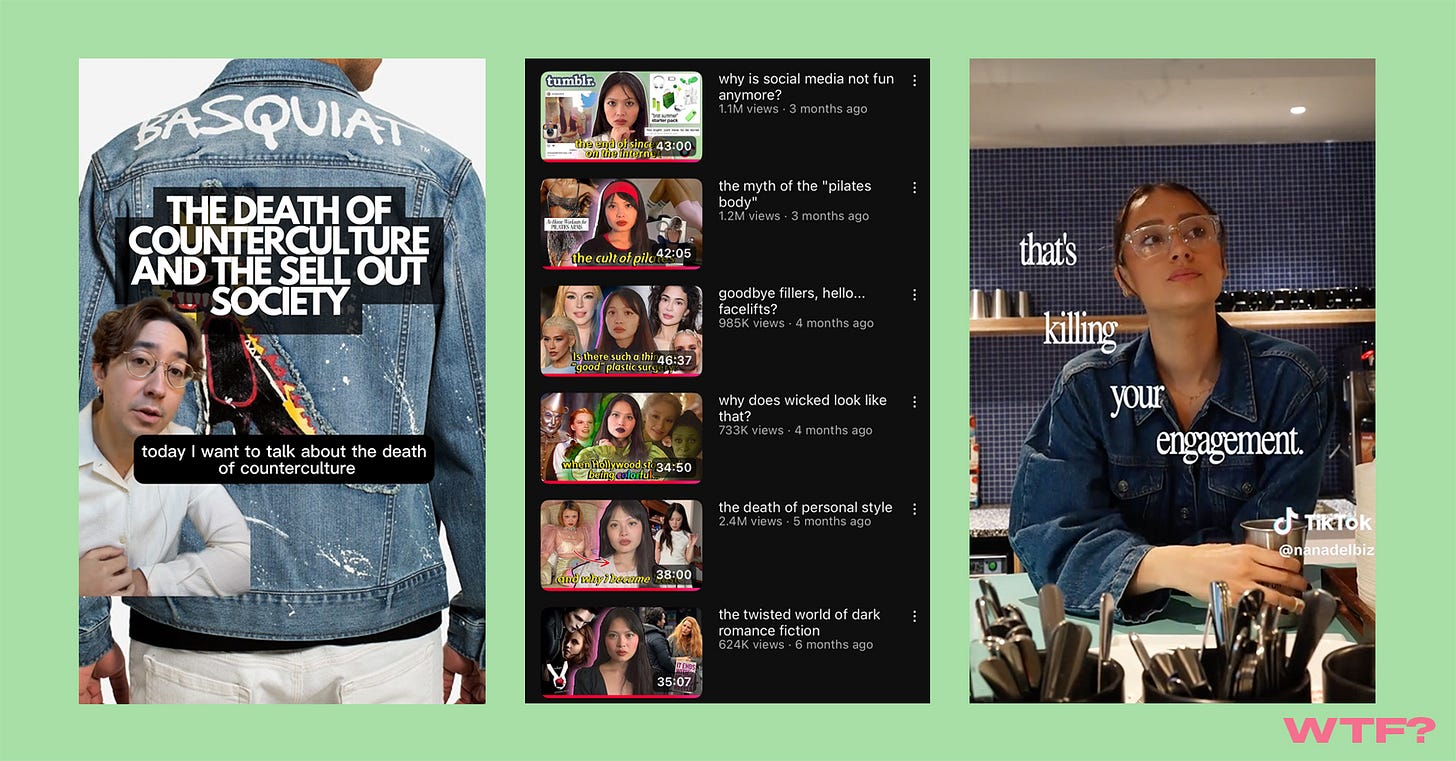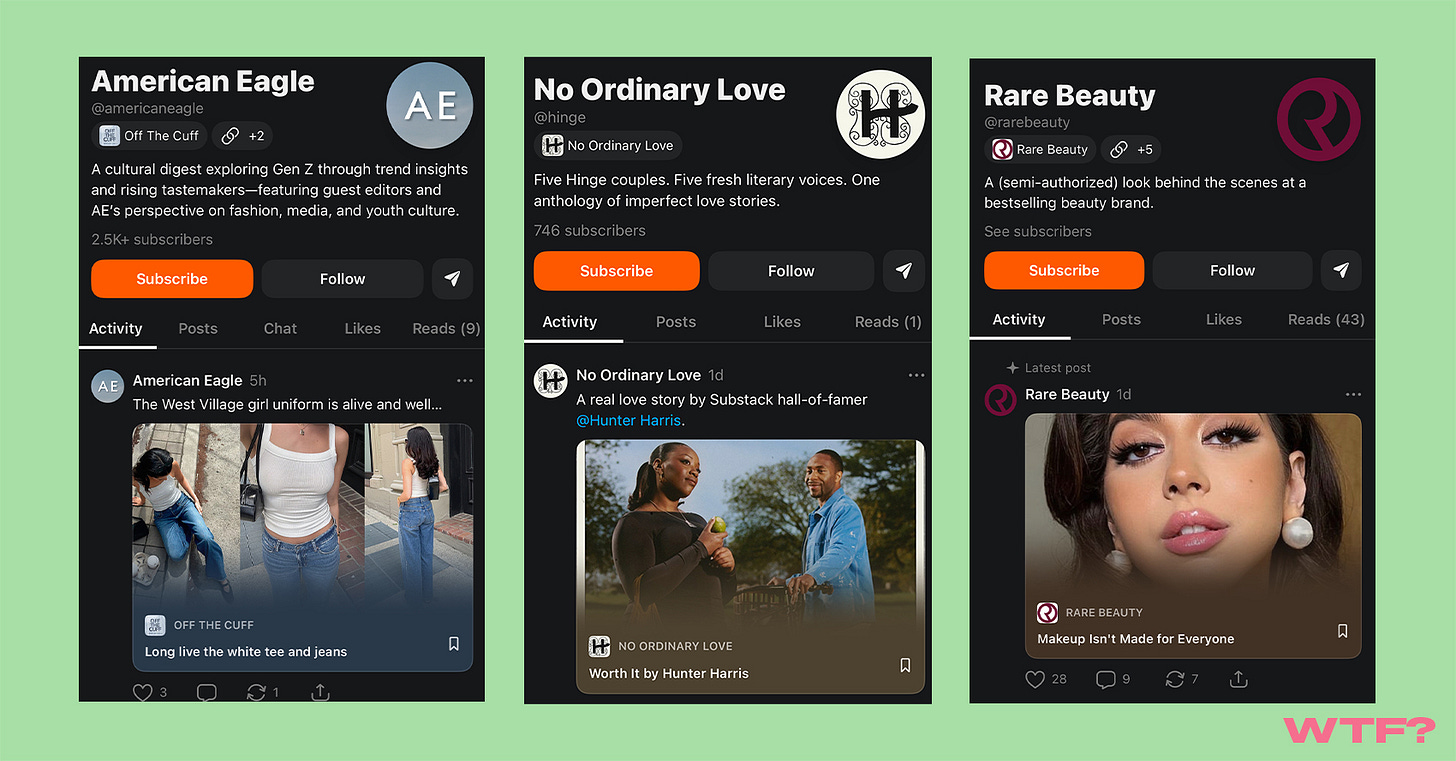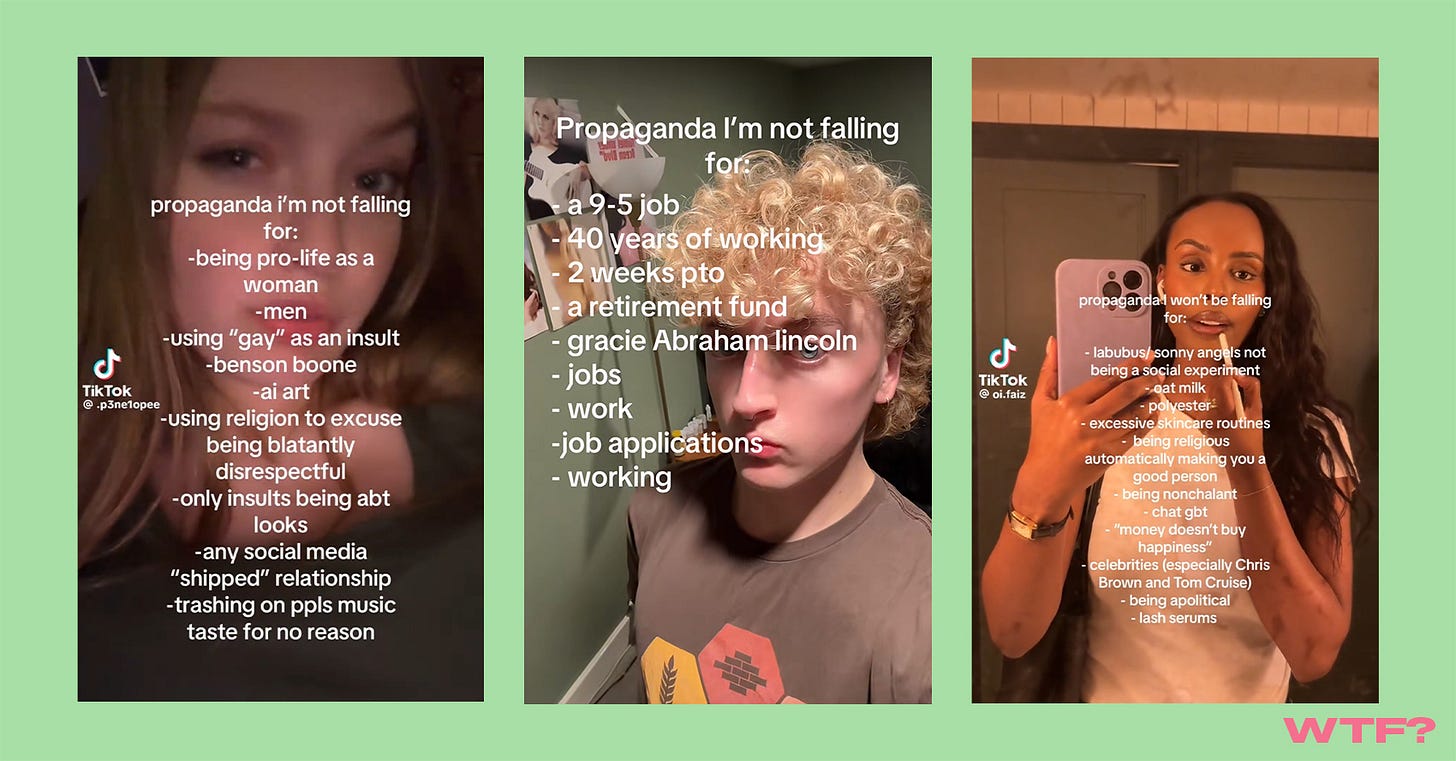wtf is everyone talking about? — issue #5
intellect is the new influence, brands bet on niche platforms, and propaganda lists
Welcome to another week of wtf is everyone talking about? 🫶
You can manage your subscriptions and choose whether or not you would like to receive this newsletter:
Also, if you end up liking this, it would really help if you clicked that ❤️ button at the bottom of your email!
Let’s get into it:
INTELLECT IS THE NEW INFLUENCE
The Tea: Absolutely loved this essay by Charlotte Mair, “The Rise of the Infotainer: Why ‘Being Smart’ is Marketable Again.” In it, Mair dives into this shift we’re seeing in the creator economy from aspirational, curated content to “infotainment” content, where intellectual credibility meets entertainment value. We’re seeing this shift play out everywhere: LinkedIn influencers dissecting industry trends, TikTok creators breaking down ways to improve your content strategy, and YouTube video essayists offering deep dives into interesting niche topics.
The Takeaway: As Mair notes, this pivot is the result of our current economic climate and the rising costs of living. Audiences are now prioritizing materials that are not only entertaining but genuinely useful and practical to the realities of their day-to-day life. I’ve even started to notice more TikTok creators sharing a round-up of intellectually stimulating content to consume to help curb doomscrolling habits. Especially amid concerns about the rise of anti-intellectualism, it’s no wonder people are gravitating toward media that frees them from the shackles of never-ending brain rot content. For brands, this presents an opportunity to position themselves as credible and trustworthy sources by creating educational-value content that’s built to last.
BRANDS BET ON NICHE PLATFORMS
The Tea: No social media platform is devoid of brand accounts for long, and Substack is no exception. Over the past few months, the number of brands launching their own Substack publications has been rising. American Eagle collaborated with Casey Lewis from After School for its Gen Z cultural digest, Off the Cuff. Beauty brands like Rare Beauty and Saie use their Substack newsletters to offer behind-the-scenes exclusives and makeup tips. Bandcamp created a music discovery newsletter to highlight new artists, and Hinge launched a five-part weekly series to share stories about the realistic moments that occur during the early stages of dating.
The Takeaway: In the aftermath of the loss of third spaces and people’s growing desire for connection, “community1” has become a keyword for many brands’ marketing strategies. It’s no surprise, then, that platforms that cater to more specific, niche interests, like Substack and Discord, are seeing a sudden influx of brands launching accounts in an attempt to deepen their relationships with audiences. But if a brand comes to these platforms using outdated promotional tactics, they’ll quickly be met with backlash. Many users have turned to such platforms to escape the barrage of traditional advertising; they want to be a part of a conversation, not just talked to. And building a genuine community takes a lot more TLC than some brands may be willing to give. If a brand wants to reap the benefits of a community-driven platform like Substack, it must commit to consistent, meaningful engagement, or as Jess Eggert recommends, consider partnerships with Substack writers (Hinge actually did this too as part of their No Ordinary Love campaign).
WHAT EVEN IS PROPAGANDA ANYMORE?
The Tea: That’s the question I’ve been stirring over after drowning in a sea of the latest social media trend, “propaganda I’m not falling for.” Over the past week, there’s been a flurry of posts where users define a diverse list of popular trends, people, products, or ideas they say they’re not buying into. Some items include labubus and sonny angels (rude), pilates, manifestations, trad wives, oat milk, and Benson Boone (Thomas, if you’re reading this, I hope you’re smiling). If you were curious to see which things came up the most, Casey Lewis from After School posted a TikTok about it here. Others have also taken it upon themselves to put together a list of “propaganda I AM falling for,” as a way to offer a different perspective on the trend.
The Takeaway: Like a lot of things that go viral on TikTok, this just feels like a repackaged format for people to share their unsolicited opinions on what they deem is “in” or “out.” And similar to its sister trend of creating “ins and outs” lists for the upcoming year, content formats like this are a quick and easy way to spark discourse on popular topics, encouraging other users to chime in with their takes, whether thoughtful or purely reactionary. What will be the next one you think: “things I believe are fake news,” “hills I’ll die on,” “glitches in the matrix?” Time will only tell…
👀 OTHER THINGS I HAVE MY EYE ON 👀
Duolingo ended their brief social media silence by…exposing themselves? If this was supposed to distract from the AI backlash, I don’t think it was very effective.
As a way to address concerns of its addictive nature, TikTok is launching a new meditation feature to help you get off the app and sleep.
Airbnb’s CEO woke up one day and said, “F*** it, we’re an everything app now” (he didn’t actually say this but I like to imagine that’s how it went down).
Apparently, selling your data is the new selling your plasma for Gen Z.
This viral Yellowstone National Park fan account is using thirst traps to draw attention to the beauty of the national park. Will the real Yellowstone please stand up?
What have you been talking about? 👀 Let me know if you have thoughts on any of the topics I mentioned or if you’re following anything new that I should spill the tea on for the next issue!
Until next time 👋
Highly recommend reading Nikita Walia’s essay on “The Community Delusion” and what brands get wrong about community building







Great insights on community building - feel this is especially relevant during these post-pandemic days. Gen Z folks are craving both deeper, more intentional connections with brands and reliable third spaces.
Will be interesting to see which niche platforms drive ROI for brands in the long run, but cool to see brands branching out for now ✍️
Definitely been seeing a ton of infotainment on my fyp and I’m not mad abt it